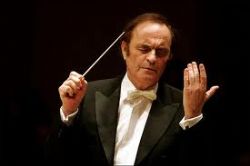|
Symphony
SRS SEASON ENDS WITH RESOUNDING TA-TA-TA-BANG
by Terry McNeill
Sunday, June 1, 2025
Symphony
YOUTHFUL VIRTUOSITY ON DISPLAY AT USO'S MAY CONCERTS
by Peter Lert
Saturday, May 17, 2025
Symphony
MYSTICAL PLANETS AND LIVELY GERSHWIN ORTIZ AT FINAL SRS CONCERT
by Peter Lert
Sunday, May 4, 2025
Symphony
VSO'S CONCERT MUSIC OF TIME, MUSIC OF PLACE
by Peter Lert
Sunday, April 27, 2025
Choral and Vocal
VOCAL ELEGANCE AND FIRE AT THE 222'S RECITAL APRIL 26
by Pamela Hicks Gailey
Saturday, April 26, 2025
CANTIAMO SONOMA SINGS AN INSPIRED GOOD FRIDAY MOZART REQUIEM CONCERT
by Pamela Hicks Gailey
Friday, April 18, 2025
DRAMATIC SHOSTAKOVICH SYMPHONY CLOSES PHILHARMONIC'S 25TH SEASON
by Terry McNeill
Sunday, April 13, 2025
LARGE COLLEGE OF MARIN AUDIENCE GREETS STOPHER ARTISTRY
by Terry McNeill
Saturday, April 5, 2025
Chamber
FRISSON DELIVERS SHIVERS OF DELIGHT
by Abby Wasserman
Sunday, March 30, 2025
OLD AND MOSTLY NEW IN SRS MARCH CONCERT IN WEILL
by Peter Lert
Saturday, March 22, 2025
|
 |
 Conductor Charles Dutoit |
LALO AND ELGAR WORKS HEARD IN SFS CONCERT IN WEILL
by Kenn Gartner
Thursday, January 31, 2013
Brilliant! That is the only word to convey the musicality, sound, and the panache the San Francisco Symphony achieved Jan. 31 in Weill Hall with of guest conductor Charles Dutoit. The sound extant during this balanced program was spectacular, and I have rarely heard such substantial fortes, ones which I had almost to cover my ears!
While the Hall’s Choral Circle’s seats were completely filled, the main section’s seats were half empty, a condition which allowed the Weill’s acoustics greater animation, despite the lowering the sound absorbing “window shades” along the walls.
Ravel’s Rhapsodie Espagnole was first on the program. Often conductors run the movements together, but Mr. Dutoit spaced the parts with a short pause between. A descending four-note motif, which appears throughout, had a thoroughly menacing effect. Clearly much of the work, indeed, most of the work, had occurred during rehearsal, and the conductor simply reminded the orchestra through his manifold gestures what should be done. If ever an orchestral work could be characterized as an “orchestral concerto,” this Ravel masterpiece from 1907 should be so labeled.
Lalo’s Symphonie Espagnole for Violin and Orchestra, Opus 21, followed. Canadian violinist James Ehnes was soloist and may be the first to perform in Weill Hall on a Stradivarius! The San Francisco Symphony’s concertmaster, Alexander Barantschik, plays a Guanerius. I was expecting a large sound from this violin but the high register did not to fill the hall as anticipated. This sonority increased a bit around the fifth section of the work, but the sound was not what one might expect from a violin of this caliber, and I must admit to some disappointment. Perhaps Mr. Ehnes put more emphasis into the performance at this moment, but for me, I had hoped for more. This violinist’s technique is masterful, and he faced every challenge in the score with aplomb, though the tone quality of the instrument did not match his or Weill Hall’s abilities. However, the audience stood, shouting bravos for quite a while, and produced large amount of applause. I too shouted bravo.
The final work on the program was Elgar’s Variations on an Original Theme, Opus 36, known as “Enigma.” There are fourteen variations upon an original theme and were composed in 1899. Each variation is a musical portrait of a friend or close acquaintance, and some of these variations have become quite familiar to audiences around the world. The only orchestral section in the entire program with which the conductor was less than successful was his too straightforward interpretation of the Nimrod or ninth variation. While other conductors may treat this music with too much sentiment, Mr. Dutoit’s interpretation was too careful and routine. I have actually seen tears come to audience members’ eyes whenever this movement is performed, and the Santa Rosa Symphony played it recently in a memorial concert.
It is not a musical requirement that the audience be so moved, but the popular work might have been more satisfactory with a broader, more emotional musical performance.
|
